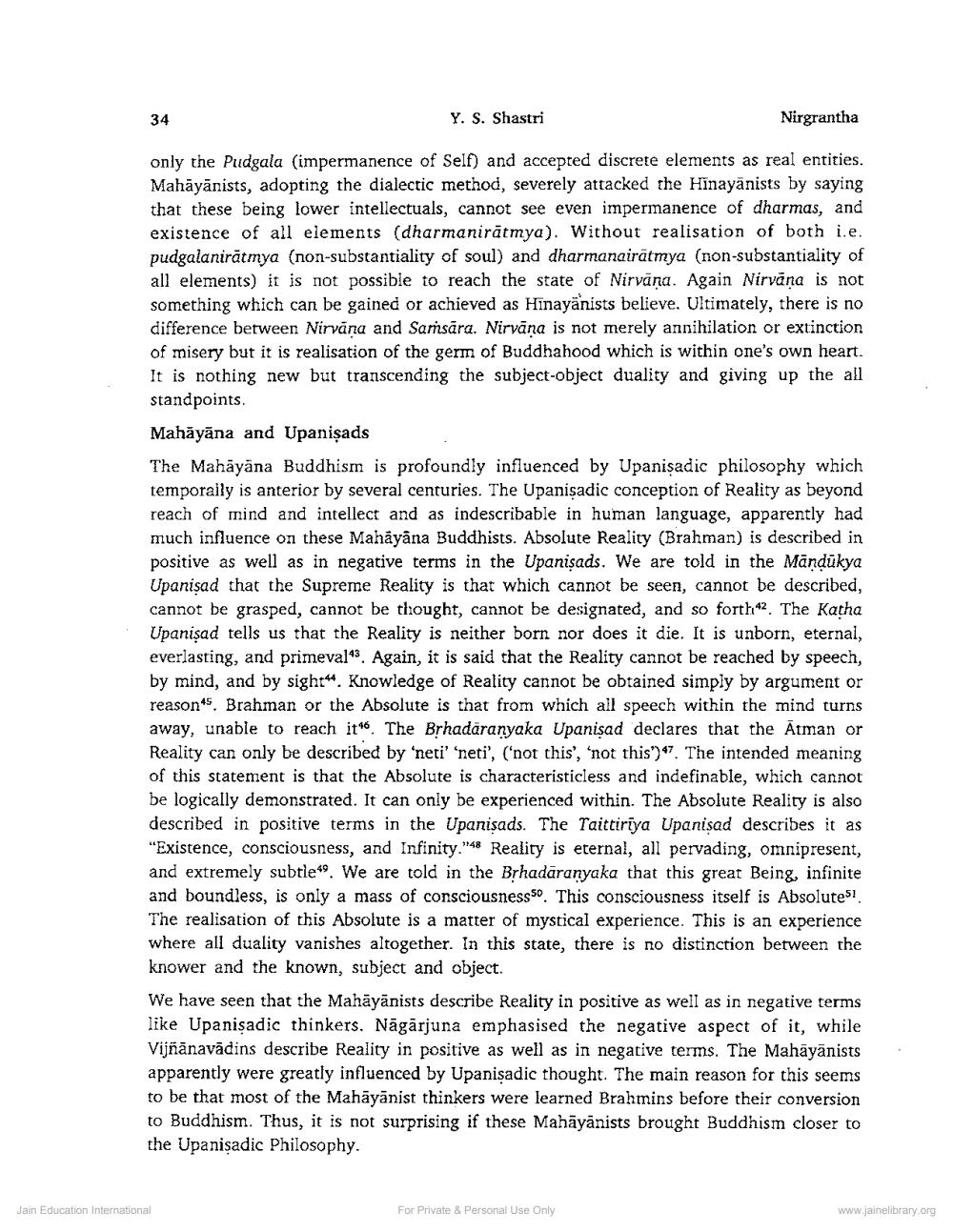Book Title: Conception of Reality in Mahayana Buddhism Author(s): Yajneshwar S Shastri Publisher: Z_Nirgrantha_1_022701.pdf and Nirgrantha_2_022702.pdf and Nirgrantha_3_022703.pdf View full book textPage 9
________________ 34 Y. S. Shastri Nirgrantha only the Pudgala (impermanence of Self) and accepted discrete elements as real entities. Mahāyānists, adopting the dialectic method, severely attacked the Hinayānists by saying that these being lower intellectuals, cannot see even impermanence of dharmas, and existence of all elements (dharmanirātmya). Without realisation of both i.e. pudgalanirātmya (non-substantiality of soul) and dharmanairātmya (non-substantiality of all elements) it is not possible to reach the state of Nirvana. Again Nirvana is not something which can be gained or achieved as Hinayänists believe. Ultimately, there is no difference between Nirvana and Samsāra. Nirvana is not merely annihilation or extinction of misery but it is realisation of the germ of Buddhahood which is within one's own heart. It is nothing new but transcending the subject-object duality and giving up the all standpoints. Mahāyāna and Upanişads The Mahāyāna Buddhism is profoundly influenced by Upanisadic philosophy which temporally is anterior by several centuries. The Upanisadic conception of Reality as beyond reach of mind and intellect and as indescribable in human language, apparently had much influence on these Mahāyāna Buddhists. Absolute Reality (Brahman) is described in positive as well as in negative terms in the Upanişads. We are told in the Māndükya Upanisad that the Supreme Reality is that which cannot be seen, cannot be described, cannot be grasped, cannot be thought, cannot be designated, and so forth 42. The Katha Upanişad tells us that the Reality is neither born nor does it die. It is unborn, eternal, everlasting, and primevalo. Again, it is said that the Reality cannot be reached by speech, by mind, and by sight“. Knowledge of Reality cannot be obtained simply by argument or reason". Brahman or the Absolute is that from which all speech within the mind turns away, unable to reach it" The Brhadaranyaka Upanisad declares that the Atman or Reality can only be described by 'neti' 'neti', ('not this', 'not this')*7. The intended meaning of this statement is that the Absolute is characteristicless and indefinable, which cannot be logically demonstrated. It can only be experienced within. The Absolute Reality is also described in positive terms in the Upanisads. The Taittirīya Upanisad describes it as "Existence, consciousness, and Infinity. 948 Reality is eternal, all pervading, omnipresent, and extremely subtle“. We are told in the Brhadaranyaka that this great Being, infinite and boundless, is only a mass of consciousnessso. This consciousness itself is Absolute5i. The realisation of this Absolute is a matter of mystical experience. This is an experience where all duality vanishes altogether. In this state, there is no distinction between the knower and the known, subject and object. We have seen that the Mahāyānists describe Reality in positive as well as in negative terms like Upanişadic thinkers. Nāgārjuna emphasised the negative aspect of it, while Vijñānavādins describe Reality in positive as well as in negative terms. The Mahāyānists apparently were greatly influenced by Upanişadic thought. The main reason for this seems to be that most of the Mahāyānist thinkers were learned Brahmins before their conversion to Buddhism. Thus, it is not surprising if these Mahāyānists brought Buddhism closer to the Upanişadic Philosophy. Jain Education International For Private & Personal Use Only www.jainelibrary.orgPage Navigation
1 ... 7 8 9 10 11
